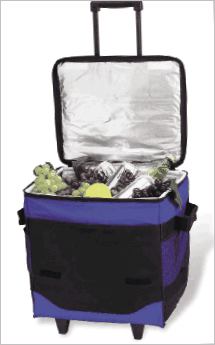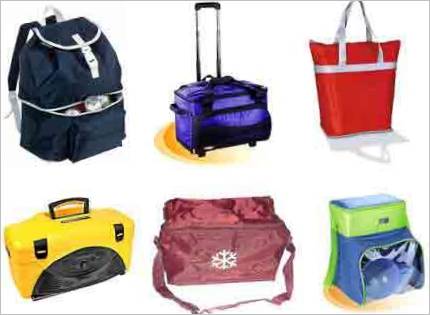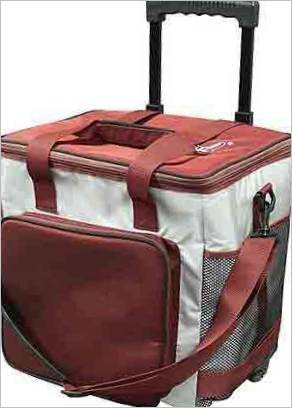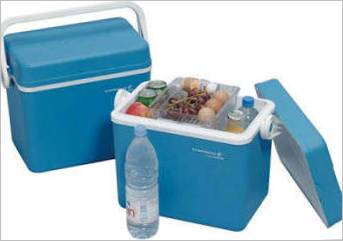More and more often we snack on the go, on the way from one office to another, and we don’t always have time to sit quietly in a cafe. And family holidays are less and less celebrated at home: picnics or simply trips with the whole family are extremely popular with city dwellers.
But it is summer outside and even in the car, despite the air conditioner, all food and drinks are getting warm very quickly. And if you’re traveling far, your food can go bad altogether.
How They Work

In official documentation car refrigerators are called as thermoelectric chambers with cooling mode or – for complicated models – with cooling and heating modes.
The principle of work of the automobile refrigerator uses the thermoelectric effect of Peltier. Inside the hermetically sealed casing, on one of its walls, there are two plates made of different metals.
Electrical current flows through them and either heats or cools them, depending on the direction of the current. The intensity of this effect depends on which metals are in contact.
Where to turn on?
Capacity of auto coolers usually is from 7 to 50 liters, power consumption – from 36 to 50 watts, they are powered from the car cigarette lighter 12 watts, rarely 24 watts . Many models are additionally equipped with a special adapter, allowing to include the refrigerator in a usual network 220 V. It is convenient if you want to use a car refrigerator on the road, on the move, and also at the final destination of your trip – for example, in the country house, where there is a power supply.
Or, what is very topical and pleasant – in a hot heated bath. A cold beer or a foggy bottle of vodka – what can be better after a hot sweat? And how it is nice to have cold drinks on a hot day at a shashlik or on the bank of any river or other similarly picturesque place.
How they keep cold?
Depending on the manufacturer and model, the interior coating of the walls of the refrigerator varies.
In refrigerators and isothermal containers produced by American manufacturer IGLOO it is polypropylene and not usual foam. Certainly, it influences the final price of a product, but at the same time lowers a threshold, which the temperature in a car refrigerator can reach.
So, according to the technical characteristics approved by the manufacturers, the refrigerators with polypropylene walls are capable of maintaining the temperature at 24-26 degrees below the ambient temperature, and the refrigerators with ordinary walls of polypropylene are only at 18-20 degrees.
By the way the material the walls of the fridge are made of is the main difference between the American made IGLOO fridges and products of their European German dealer manufactured under the brand Ezetil.
It should be noted that regardless of the ambient temperature the temperature inside the automobile refrigerator will not drop below zero degrees Celsius. This is stated by all manufacturers: because the temperature below zero is already freezing products, and the car power is simply not enough for this. For these purposes it is better to use usual, stationary compression refrigerators.
Mobility is the main thing!

A great advantage of automobile refrigerators and isothermal containers is their compactness and mobility.
There is serious competition in the market between the manufacturers of these products, and one of the main parameters is the convenient operation of the refrigerator both in the car and in stationary conditions.
Some modern models can be used as a mini fridge or mini bar in the office and at home, as well as at home.
Yes, by the way, the automobile is not the unique moving device where it is possible to use portable refrigerators. You might as well plug your favorite model into the “cigarette lighter” in a truck, trailer or even a motorboat.
A little about design
A few words about the design of auto refrigerators and isothermal containers. Except for several vertical models, refrigerators are loaded from the top, closed with a lid with a latch and have a convenient, ergonomic handle.
One cannot help noticing a very original approach of American company IGLOO to the question of design. It is almost impossible to forge the refrigerators of this brand – to be exact, it is possible to forge it, but the punishment is inevitable.
And the point is in the original idea: in profile the majority of refrigerators IGLOO reminds the traditional dwelling of Eskimos – igloo. Hence, the name of the American company – the pioneer in the autorefrigerator industry – comes from.
Cold accumulators – indispensable detail
Almost all car refrigerator manufacturers offer products like rechargeable batteries. Many people are familiar with this name from conventional, compression refrigerators – more and more often lately, cold batteries come with the appliance and are usually stored in the freezer compartment.
They are containers filled with a non-freezing fluid that ensures that the temperature inside the freezer remains below zero for 9-24 hours depending on the model in the event of an unpredictable power failure.
By the way, you can use the rechargeable coolers separately: for example, they will cool the meat marinated for barbecue on the way to the picnic. Sometimes heavily salted water is placed in the refrigerator instead of a special liquid that does not freeze at zero, but at lower temperatures. Portable cold batteries are usually thawed out, i.e. e. Give out the cold, for 12 hours.
The patties will stay hot!

In car refrigerators with heating function, when you switch to this mode, the internal temperature rises to 52-66 degrees Celsius. Of course, isothermal containers are not designed to reheat chilled foods, but to keep hot foods hot.
Those models of car refrigerators that can operate in both cooling and heating modes of operation are usually connected to a power source through a special cable that can be connected to the refrigerator in two ways.
At the place of cable connection there is a special tip with two small holes and marks – red designation of heat and blue designation of cold , and depending on which side of the cable will be put to the symbol point on the body of the fridge, it will either cool the food or keep it warm.
It should be noted that all models of car refrigerators without exception retain cold much better than heat: so, the food placed inside will remain cold for at least a day, while hot food will remain for only a few, usually no more than four hours.
It is recommended that the refrigerator be run for about half an hour before food is loaded in order to conserve temperature in the most efficient manner.
Thermoelectric appliances can be affected by extremely low or high ambient temperatures, as well as by direct solar radiation. The best effect is achieved if pre-cooled food or beverages are placed inside the chamber.
Like any stationary appliance, it will be easier for a car refrigerator to maintain the temperature of a pre-cooled beverage than to chill a warm or room temperature beverage.
How the cold got into the bag
The first recorded evidence of portable “refrigerators” dates back to the 1930s. Modern cloth refrigerator bags have a volume of 5 to 30 liters. They are made of durable fabric like nylon and have double walls, between which lay a thermal insulating layer of polyethylene foam.
Nowadays the technology of producing refrigerator bags has improved: for example, the Thermos company produces the walls of bags combining several types of materials of different density, a “silver” layer is applied on the surface that reflects the direct sunlight.
The undoubted advantage of refrigerator bags over thermocontainers is their compactness: they can all be folded up and take minimum space when folded.
First they played with a thermal box
The history of thermal containers began with the production of wooden crates, lined with styrofoam inside: this is what is called in the modern language isothermal containers containers, bags etc . p. .
The styrofoam allowed to keep the interior of the box cooler for a longer time. The novelty was extremely popular: 15,000 thermoboxes of various capacities – 8, 16 and 28 liters – had been sold in the United States by 1955.
Gradually the wooden crates were replaced by plastic thermocontainers. Of course, they were not yet fridges in the direct sense of the word, as they could only keep cold heat but not create it.
Nowadays, most such containers keep cold for 24-30 hours, but the newest professional models are able to maintain a low temperature for up to five days.
Basically, these insulating properties are achieved through the large width of the walls up to 6 cm . Thermocontainers come in a variety of capacities, from 10 to 250 liters, and are used in both households and industry.
Then the bag became a car cooler
Twenty years later, when cars were in almost every household in North America, the first automotive refrigerators were invented. The Americans began creating special automotive coolers by 1972, in conjunction with NASA.
The birthplace of modern car refrigerators is Houston, Texas – that’s where the first model was manufactured. It is said that the initiators of automobile refrigerators were residents of hot American states: drivers who delivered milk to farms began to complain that the products reached the consumer in not quite fresh form.
Then savvy Americans came up with the idea of a special automobile refrigerator which could be powered by a battery and, taking up a minimum amount of space, keep food fresh.
Some time later the idea got a real implementation, and in a few years the first automobile refrigerators also appeared in the assortment of European manufacturers. Although it is still the United States that takes the lead in making automobile coolers – for the simple reason that Americans are very mobile. After all, as one of modern glossy magazines once reasonably pointed out, “every American film or book has a hero who goes somewhere”.
Tips from the fridge bag

The efficiency of the car cooler increases. . so the cold is preserved longer if the interior space is filled as much as possible. This means that you should not expect miracles, putting two bottles of beer inside the fridge to drink them cold in a day or two. And if you load a whole box of beer in the fridge, the chances of indulging in a cold one will be much higher.
Please also note that it is not recommended to use the vehicle cooler in a confined space, such as in the trunk of a car.
An exception are air-conditioned cars, but even here it’s better to be on the safe side: nobody can say what temperature is maintained in the trunk while you are driving along the highway on a hot summer day, even if a pleasant coolness is poured in the cabin.
And it is obvious that the fridge, no matter how technologically advanced it is, will not maintain the temperature inside effectively if placed in 50-degree heat.
A few rules should be strictly observed for the long-term use of the cooler:
1. Never use pre-cooked ice in the operation of the device: the water formed when it melts can lead to corrosion of the fan and engine parts.
2. Do not forget to clean regularly the plugs of the power cord and car cigarette lighter jack: the presence of tobacco chips can cause serious malfunction of the refrigerator.
3. Never use abrasive or harsh detergents to clean the interior. Optimal care is a warm, damp cloth soaked in a mild soap solution or soda solution.
What are the thermo-refrigerators?
|

What is the best way to keep beer cool during a picnic?
What would be the best way to keep the beer cool during a picnic?